|
| |
Bendable Beauty
QUESTION:
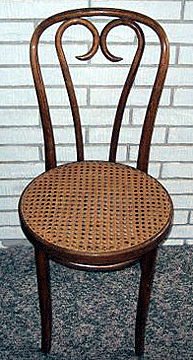 I
recently purchased two bentwood chairs at an antique shop in a nearby
town. Both have woven cane seats and the number “14" pressed into the
wood under the rim of the seat. I bought them to use in my kitchen. The
cane is in good condition and the chairs are stained a dark brown. Can
you tell me anything about these chairs—who made them and how old are
they? I
recently purchased two bentwood chairs at an antique shop in a nearby
town. Both have woven cane seats and the number “14" pressed into the
wood under the rim of the seat. I bought them to use in my kitchen. The
cane is in good condition and the chairs are stained a dark brown. Can
you tell me anything about these chairs—who made them and how old are
they?
Thanks,
Kathleen
______________________________________________________
ANSWER:
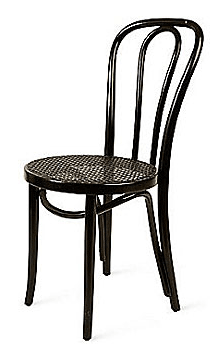 Your
chairs are commonly known as “bistro” chairs, and while most people
think they date from the early 20th century, they actually date back
to the mid 19th century. Your
chairs are commonly known as “bistro” chairs, and while most people
think they date from the early 20th century, they actually date back
to the mid 19th century.
Michael Thonet (pronounced “toe-net”), a clever and creative
cabinetmaker from Boppard am Rhein, Germany, invented the process
for bending wood and as a result created the first pieces of
bentwood furniture. He originally made your chairs in 1859, however,
his company, which is still in existence, made over 50 million by
1930. So yours could date from the early 20th century.
Thonet, the son of master tanner Franz Anton Thonet, started out as
a carpenter's apprentice in 1811. Eight years later, he opened his
own shop. In the beginning, he carved his pieces from European
beechwood.
Thonet simplified the complicated technical properties of wood:
explored the limitations of its flexibility, and developed a new
type of design with an appeal that reached far beyond its novelty.
His furniture designs were simple and graceful with a distinctive
quality that belied their true strength.
In the 1830s, Thonet began trying to make furniture out of glued and
bent wooden slats. His first success was the Bopparder
Schichtholzstuhl, or Boppard layerwood chair, in 1836. The following
year, he purchased the Michelsmühle, the glue factory that made the
glue that he used. However, he failed to obtain the patent for his
new process in Germany and England in 1940, so he tried again in
France and Russia the next year, but again failed.
The steam engine appeared on the scene around the time that Thonet's
was experimenting with his bending process. He discovered that he
could bend light, strong wood into curved, graceful shapes by
forming the wood in hot steam. This enabled him to design elegant,
lightweight, durable and comfortable furniture, which appealed
strongly to style trend at the time. His pieces were a complete
departure from the heavy, carved designs of the past.
At the Koblenz trade fair of 1841, Thonet met Prince Klemens Wenzel
von Metternich, who was enthusiastic about Thonet's furniture and
invited him to his Vienna court. During 1842, Thonet presented his
furniture—particularly his chairs—to the Imperial Family. On July 16
1842: Metternich granted Thonet the right "to bend any type of wood,
even the most brittle: into the desired forms and curves by chemical
and mechanical means." The Prince granted him a second, nonrenewable
13-year patent on July 10, 1856 "for manufacturing chairs and table
legs of bent wood, the curvature of which is effected through the
agency of steam or boiling liquids.”
Beechwood: proved to be less prone to splitting than other kinds of
wood, such as oak or birch. After placing the rods of beech in a
pressure vessel, Thonet applied steam until the resin surrounding
the timber fibers became pliable. In this changed state, he could
bend the rod around a form .Once the rod had taken shape, he would
leave it to cure. The hardened resin would effectively hold the
timber fibers firm in the new shape, which he could then use as a
solid component in the manufacture of bentwood furniture.
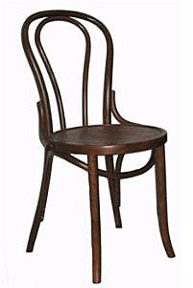 Protected
by patent, Gebruder Thonet was to be the only firm in the
Austro-Hungarian Empire for more than a decade that could legally
produce bentwood furniture.. Protected
by patent, Gebruder Thonet was to be the only firm in the
Austro-Hungarian Empire for more than a decade that could legally
produce bentwood furniture..
When his first factory in Boppard establishment got into financial
trouble, he sold it and moved his family to Vienna, where in 1849,
he opened a new factory called the Gebrüder Thonet. In 1850, he
produced his Number 1 chair, which he intended to sell to café
owners.
He received a bronze medal for his Vienna bentwood chairs at the
London World's Fair in 1851, at which he received international
recognition. At the next World's Fair in Paris in 1855, he received
the silver medal for his new and improved bentwood chair design. In
1856, he opened a new factory in Korycany, Moravia because of the
country’s ample supply of beechwood.
By 1859, he developed his most famous chair—the Number 14, known as
Konsumstuhl No. 14 or coffee shop chair No.14—for which he finally
received a gold medal at the 1867 Paris World's Fair. It became the
most popular chair manufactured in the 19th century.
Thonet produced his No. 14 chair using six pieces of steam-bent
wood, ten screws, and two nuts. He made the wooden parts by heating
beechwood slats to 212 °F, pressing them into curved cast-iron
molds, then drying them at 158 °F for 20 hours. The chairs could be
mass-produced by unskilled workers and disassembled to save space
during transportation—an idea used today by the Swedish company IKEA
to flat-pack its furniture.
Minimal in its design and economical in its use of material, the No.
14 chair employed elements later seen in classical modernism. The
production model, which appeared in the late 1850s, spanned the
transition from workshop to factory production. A complete economy
of process, suitable for mass production, distinguished Thonet’s
final model.
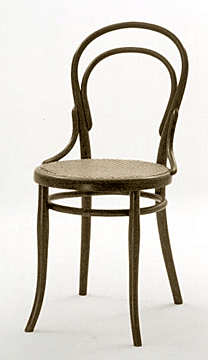 Thonet’s
company, Gebruder Thonet, entered the No. 14 chair in many
industrial fairs. Its success prompted the opening of branches
throughout Europe in the 1860s. The variety of models manufactured
by Thonet broadened to include furniture for work and leisure, for
public and private use. Before long, patrons in fashionable cafés
all over Vienna sat on his bentwood chairs while enjoying their
coffee. Thonet’s
company, Gebruder Thonet, entered the No. 14 chair in many
industrial fairs. Its success prompted the opening of branches
throughout Europe in the 1860s. The variety of models manufactured
by Thonet broadened to include furniture for work and leisure, for
public and private use. Before long, patrons in fashionable cafés
all over Vienna sat on his bentwood chairs while enjoying their
coffee.
Gebruder Thonet launched the No.18 chair in 1876, one of a group of
chairs with back inserts of curves and loops of bentwood. With the
insert reduced to this single loop, the chair is more stable and
more comfortable than No.14, since it provides support for the back
without touching the spine.
The company introduced the tip-up theater chair in 1888. Designed
for the new Deutsche Volkstheatre in Vienna, its impact was
revolutionary and soon theaters all over Europe began ordering it.
To most, bentwood stands as the shining example of what can be
achieved through design. Its form both expresses and symbolizes the
manufacturing process that lays behind it. Technically simple, it
was the embodiment of the principles of mass production: inexpensive
to manufacture, transportable in large quantities, and it was strong
and durable, making it an excellent choice for commercial use.
The firm’s later chairs used eight pieces of wood and also had two
diagonal braces between the seat and back to strengthen that
particular joint. The basic technique of making furniture from bent
materials hasn’t changed significantly since the 19th century.
Today, a pair of No. 14 chairs with a matching table is selling on
eBay for nearly $1,000.
<
Back to Readers Ask Archives
Next Article > |
|
 |
|
FOLLOW MY WEEKLY BLOG
Antiques Q&A
JOIN MY COLLECTION
Antiques and More
on Facebook
LIKE MY FACEBOOK PAGE
The Antiques
Almanac on Facebook |
|
No antiques or collectibles
are sold on this site.
|
|
How to Recognize and
Refinish Antiques for Pleasure and Profit
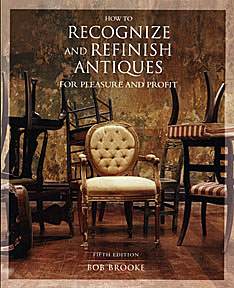
Have
you ever bought an antique or collectible that was less than perfect and
needed some TLC? Bob's new book offers tips and step-by- step
instructions for simple maintenance and restoration of common antiques.
Read an
Excerpt
|
|

|
|
|
|
|
